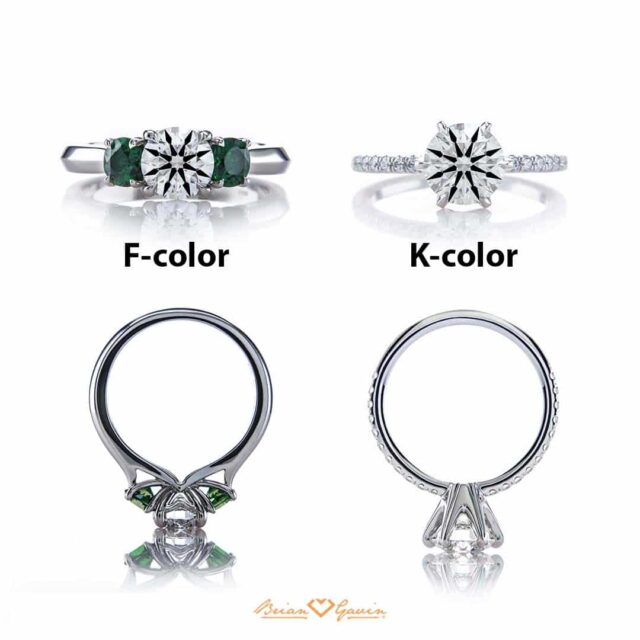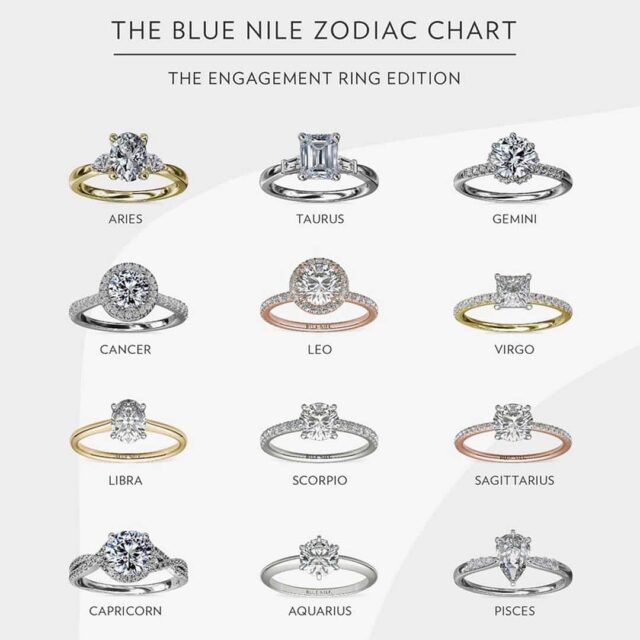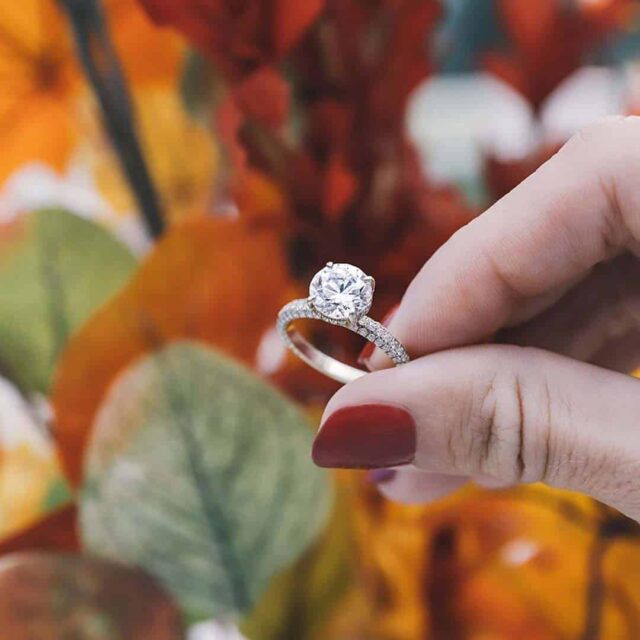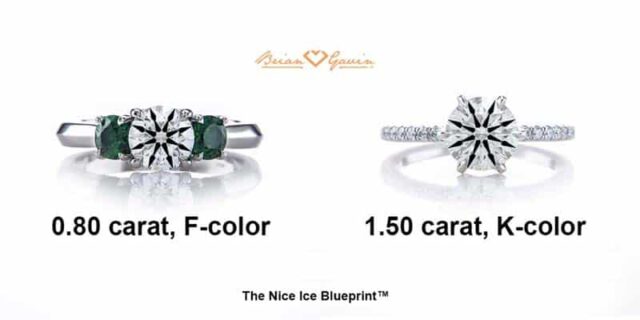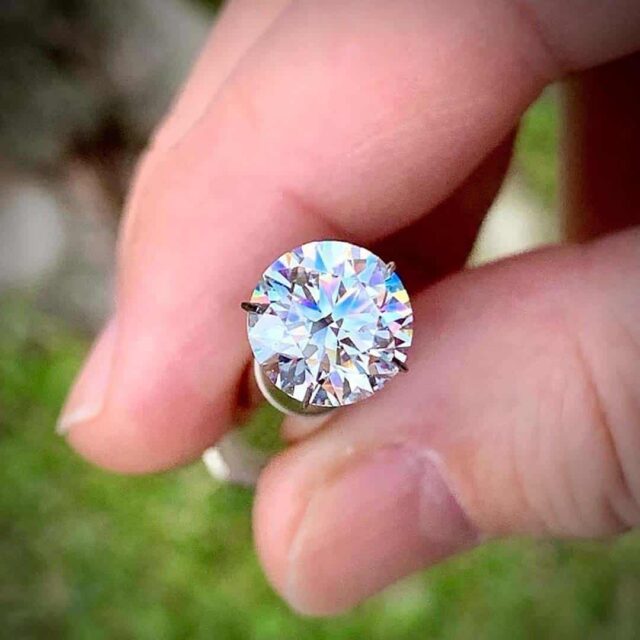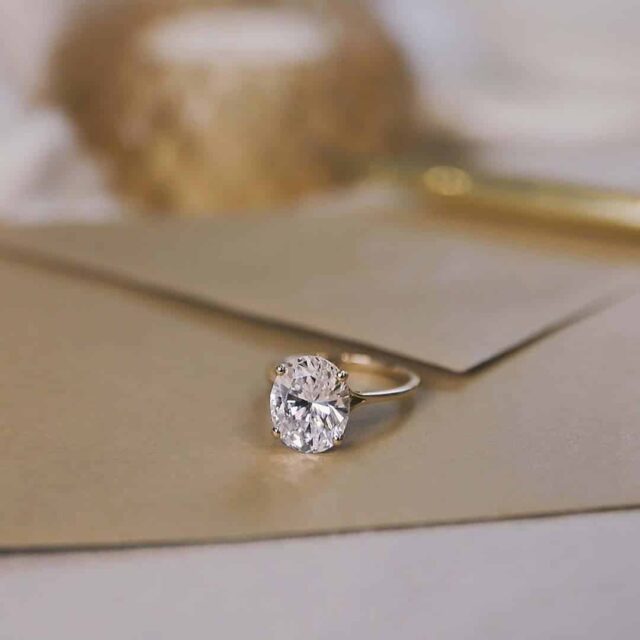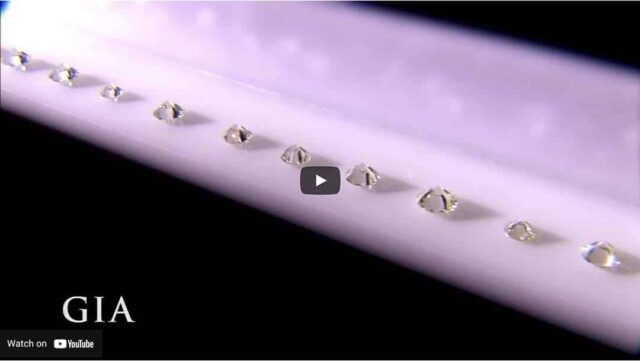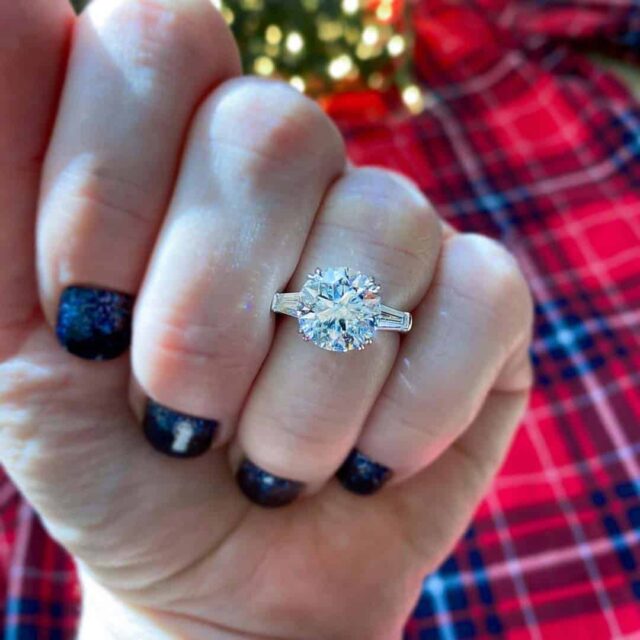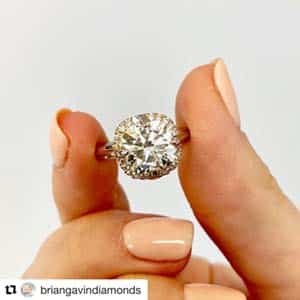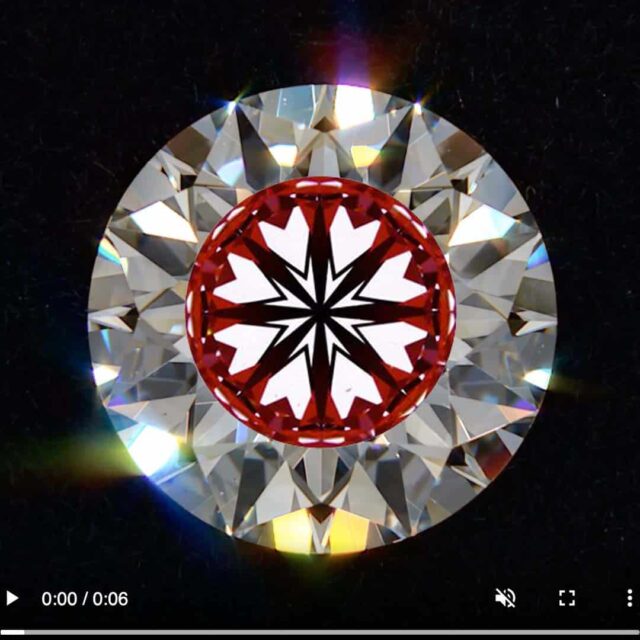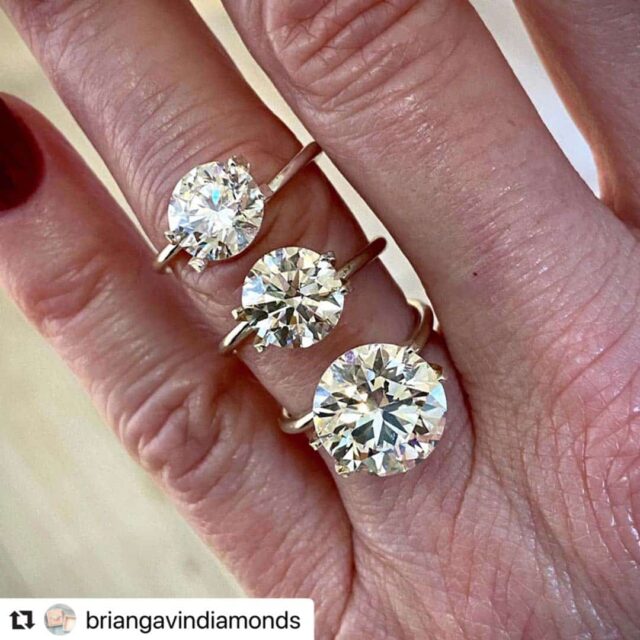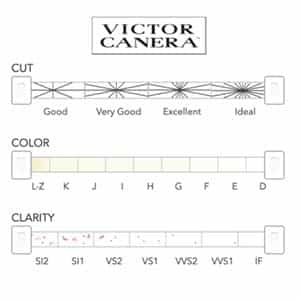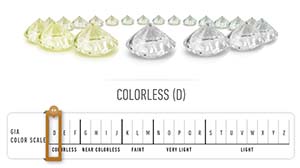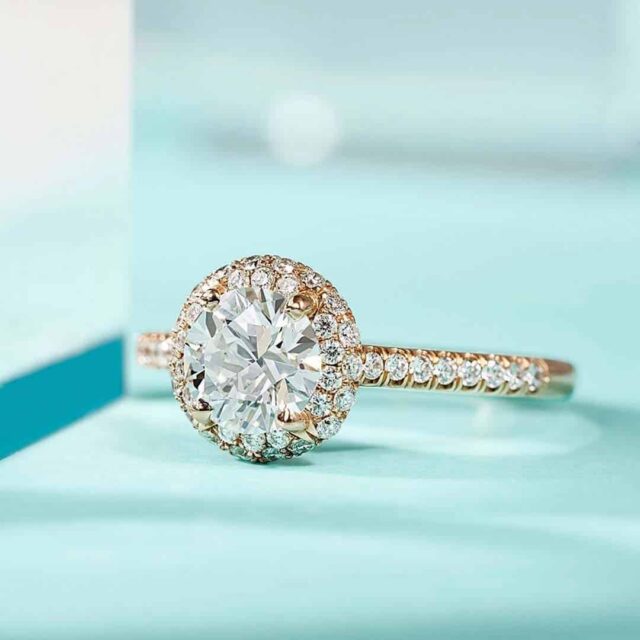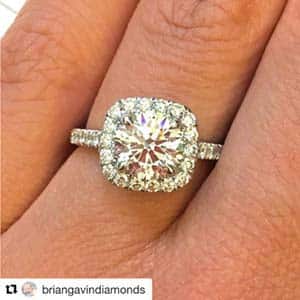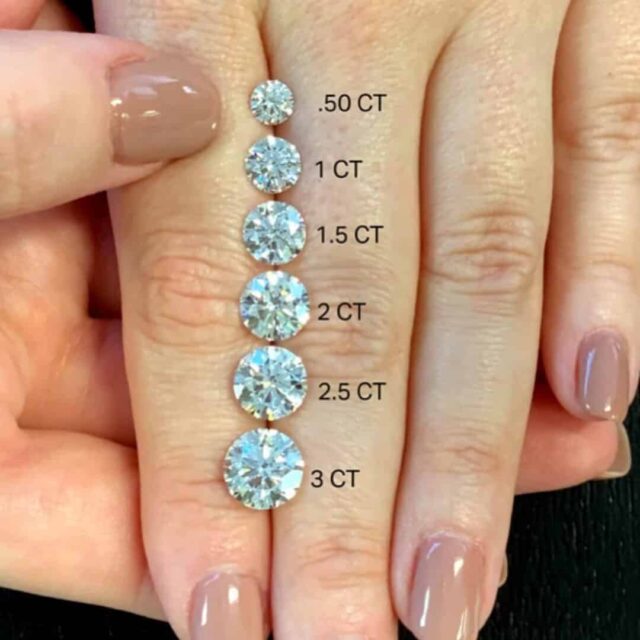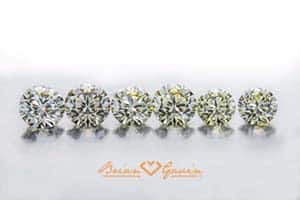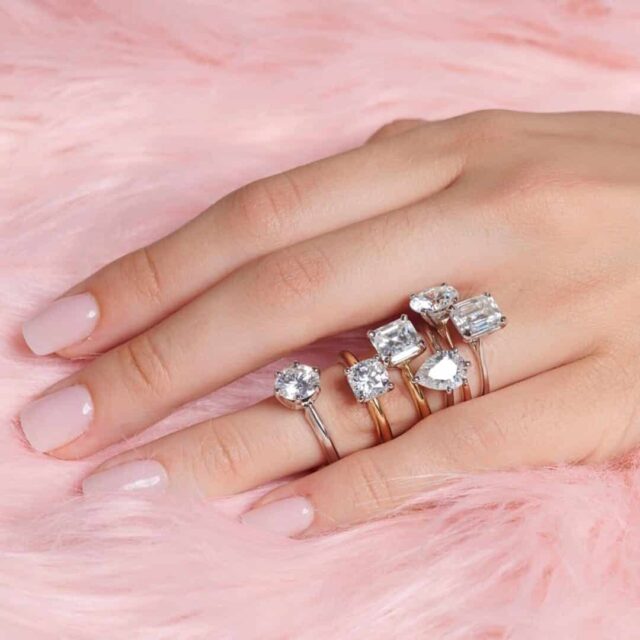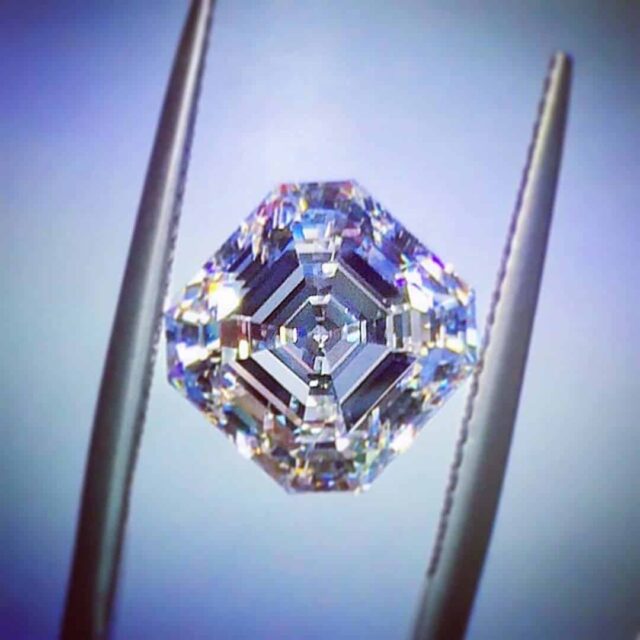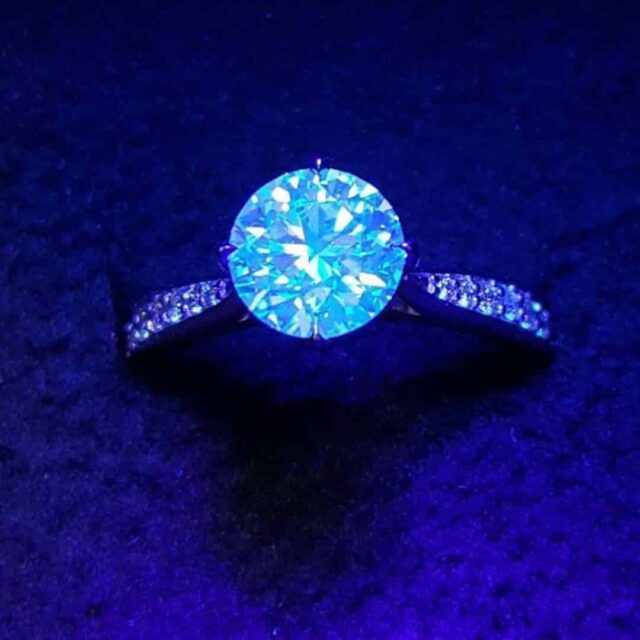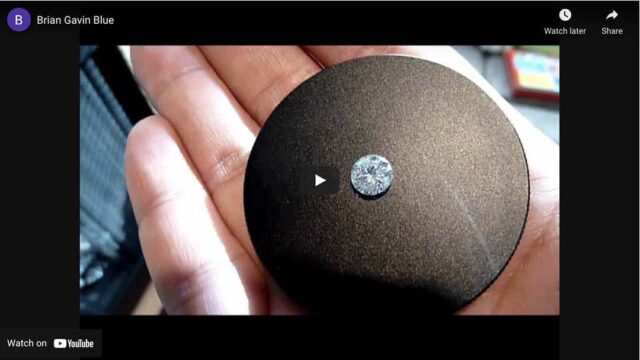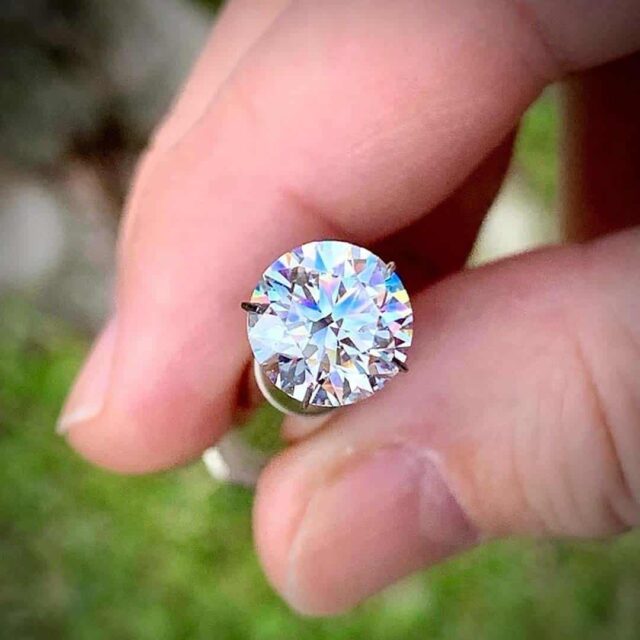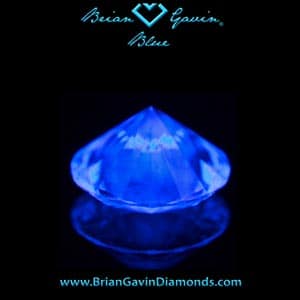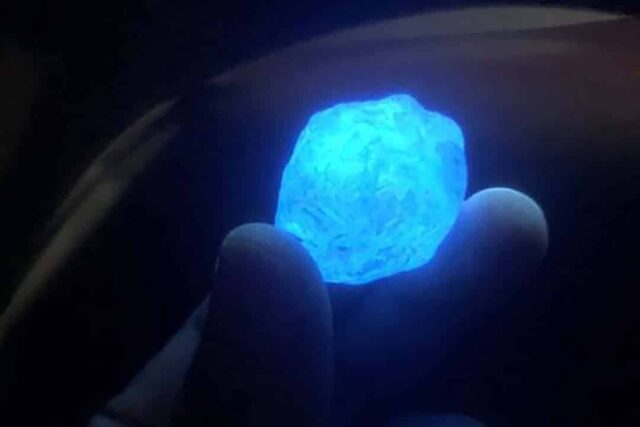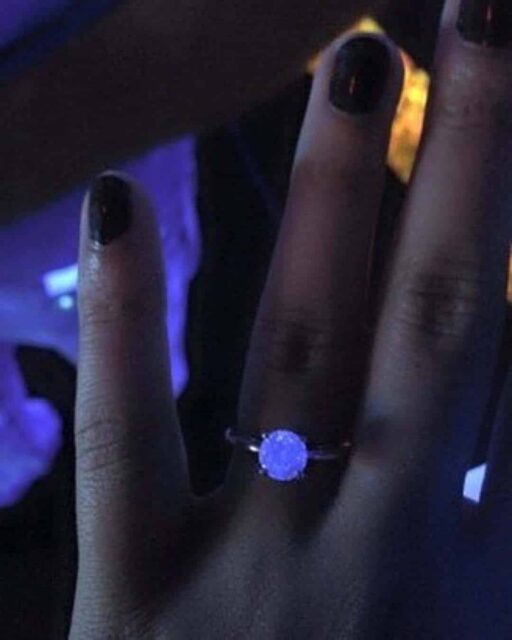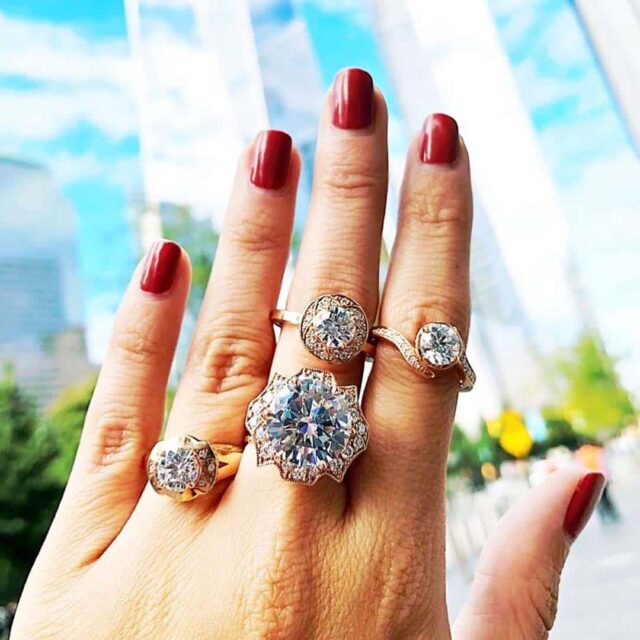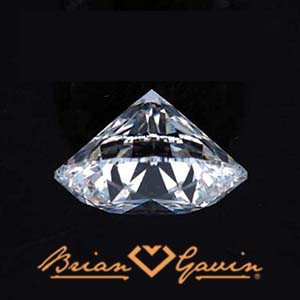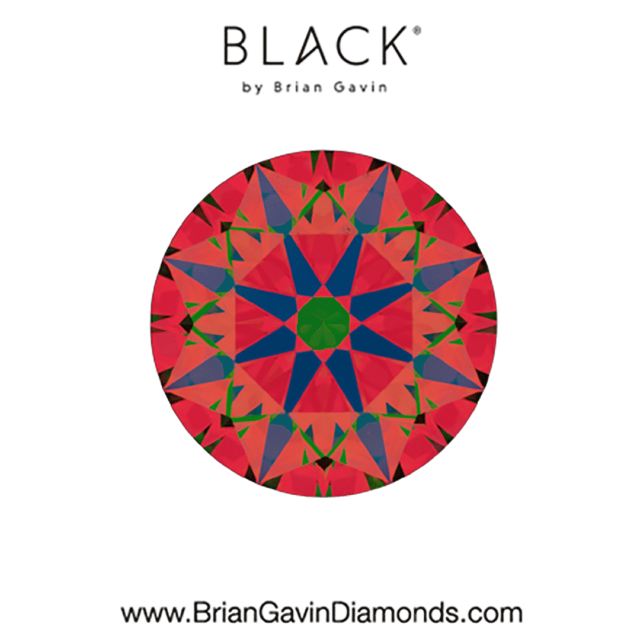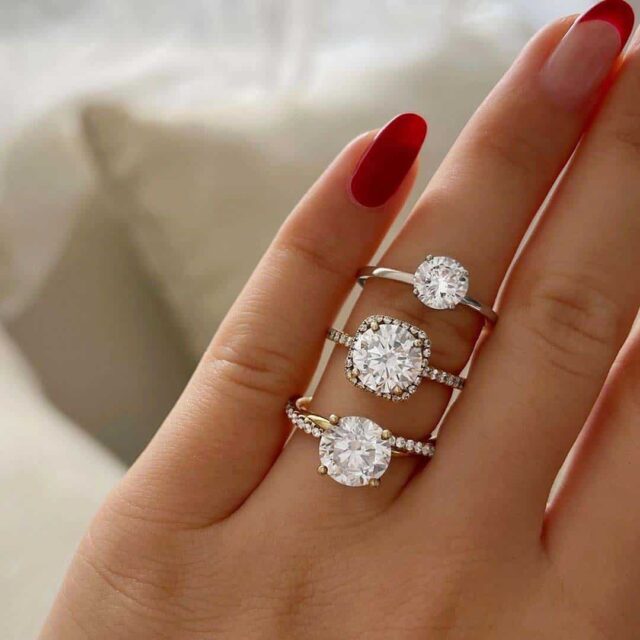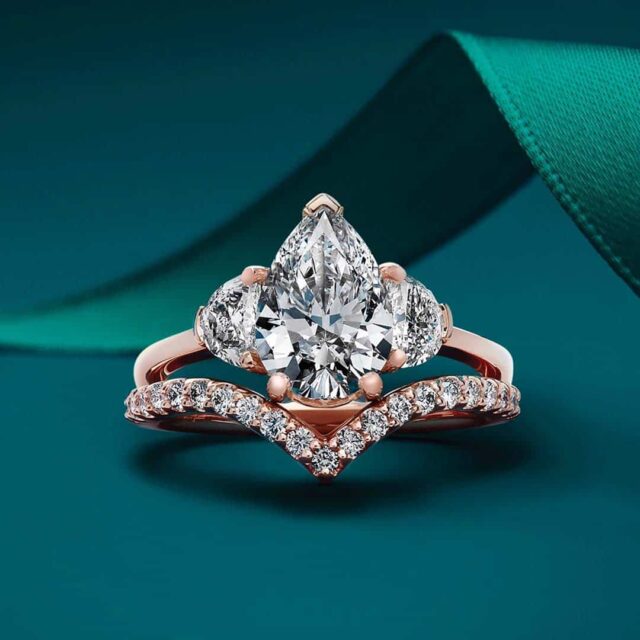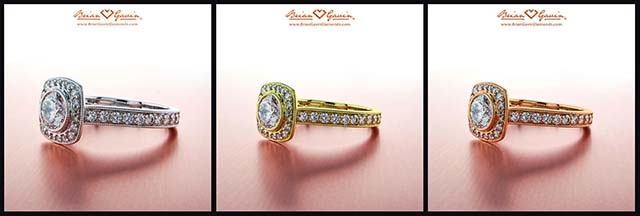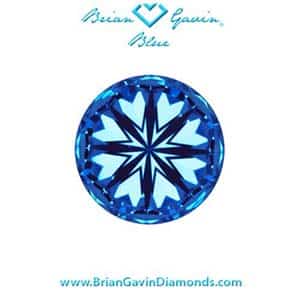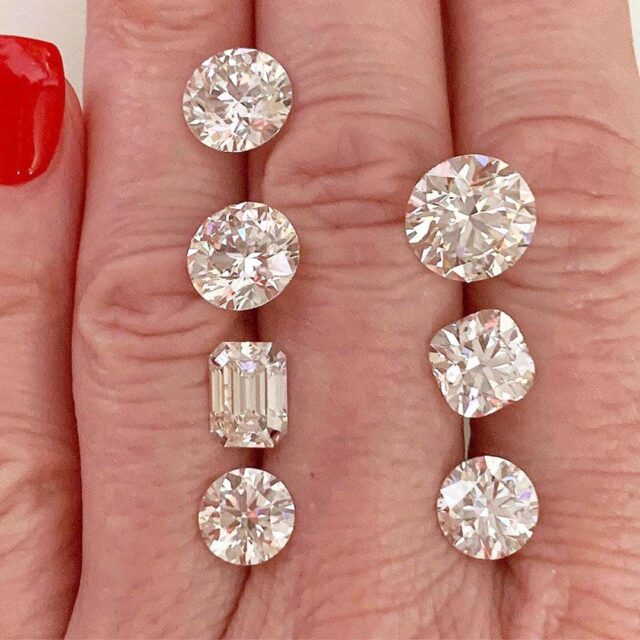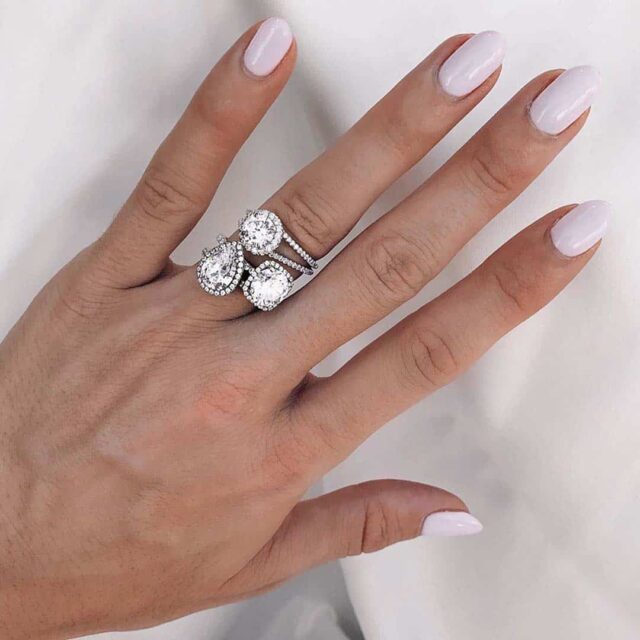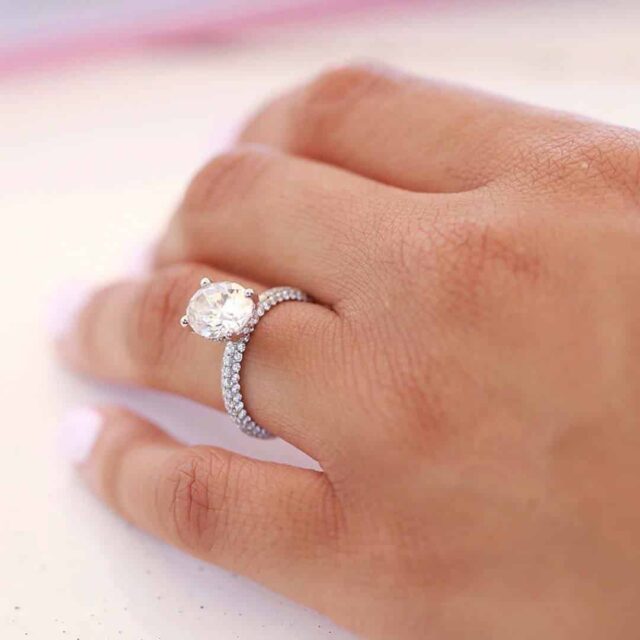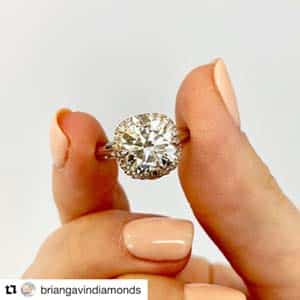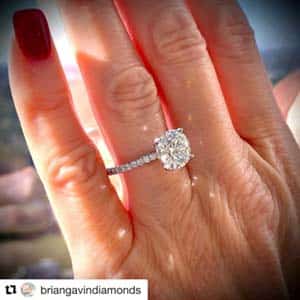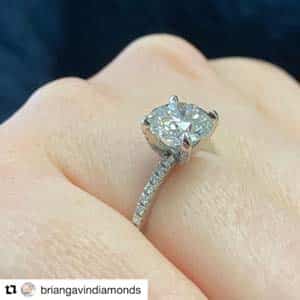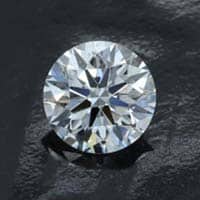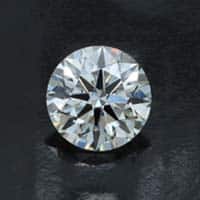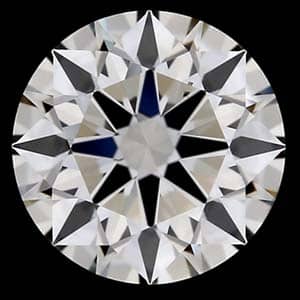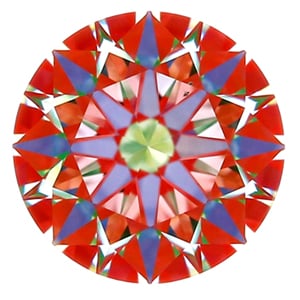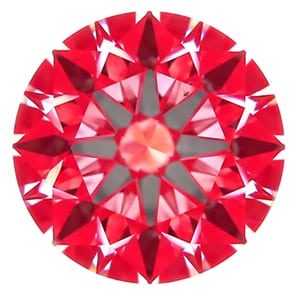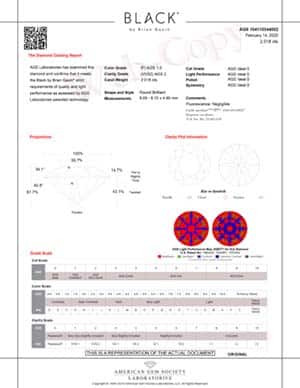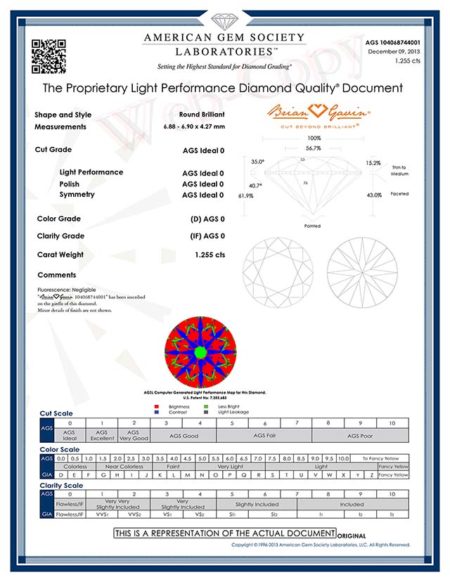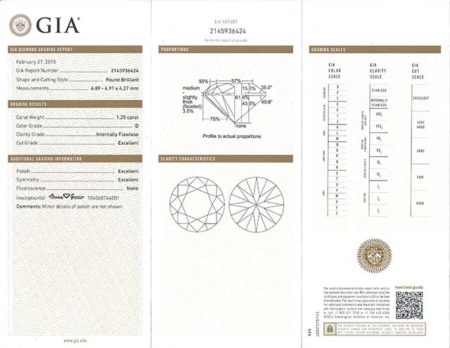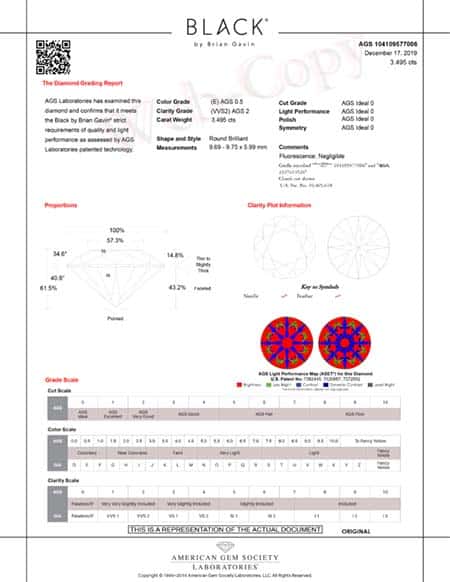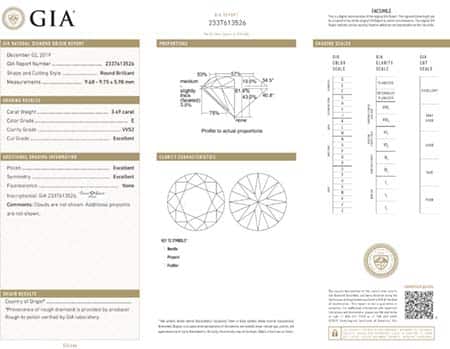Congratulations for showing the initiative to learn more about diamond color grading today! Most people don't invest the time to learn about diamonds before they buy.
Instead, they wander into jewelry stores like lambs going to the slaughter. Then they proudly announcing their intent to buy an engagement ring and don't discover the mistakes they've made until later.
Of course, you'll see a few people might be carrying around one of those prehistoric Diamond 4C's pamphlets. However, the vast majority of them don't know anything about buying little sparkling rocks.
Consequently, some retail jeweler is likely to skin them alive! But that's not you. You're the type of person who takes the time to research things before you buy them.
In that case, I want to welcome you to the World of Nice Ice. We specialize in Hearts and Arrows Super Ideal Cut Diamonds and are passionate about light performance.
The Haunted Mind of Diamond Color:
You might be wondering what diamond color and haunted houses have in common. In the first place, there are many kinds of people in the world. With that in mind, people are apt to believe in different things.
At the same time, people are surprisingly similar and share superstitious beliefs. Although this may be true, it's a rather startling concept when you stop to think about it. For example:
How Does This Relate to Diamond Color?
That last statistic proves that fewer and fewer people are paying any attention to their mother-in-law. However, all of these statistics are based loosely on my interpretation of the Harris poll.
For the task at hand, we merely want to demonstrate that there are many kinds of people worldwide. At the same time, many of those people have extreme opinions about specific types of things.
Like what style of engagement ring is right for your astrological sign according to Blue Nile, or the diamond color grade you should choose for your engagement ring. Be that as it may, the reality is that it's all a matter of personal preference and taste.
The Colored Court of Public Opinion:
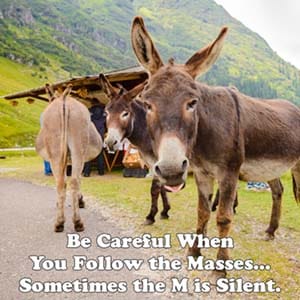
While some of the things that other people believe might be helpful, other things can cause more harm than good. For example, sometimes somebody might tell you to stay away from specific places or things.
They might do so because those things are scary or unfamiliar to them. However, given the freedom to decide those things for yourself, you might discover that you enjoy them. On the other hand, you might not be interested in those things at all.
However, you owe it to yourself to make up your mind based on your individual preferences. The last thing you should do is follow the masses.
Relax. We're Rattling Your Chain:
With that in mind, this article serves to quiet the Haunted Mind of Diamond Color. After all, it has trapped many a poor soul who has been foolish enough to follow the wave of public opinion.
Imagine those poor souls throwing away senseless piles of cash on the condition that their diamond won't be bright white. In other words, a lot of people pay a premium for colorless diamonds when they can't see the difference.
Oh, lemmings, poor lemmings, let me show you the way to understanding diamond color for yourself. After which, you can donate all of the money you will save to the Cult of Nice Ice.
Little Miss Muffet's Tuffet:
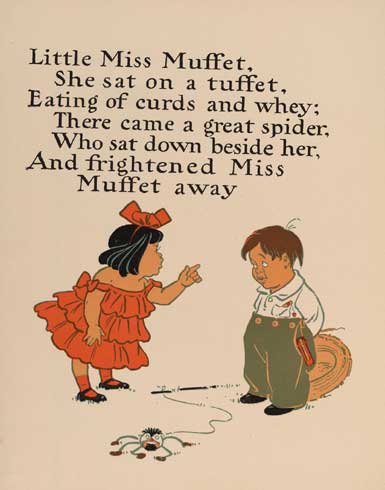
Of course, you know Little Miss Muffet's story, she sat on her tuffet eating her curds and whey. Then, along came a spider, Who sat down beside her, And frightened Miss Muffet away!
Although this may be true, there is much more to the story you might find quite interesting. Because the truth is that Little Miss Muffet was not fearful of spiders in the beginning.
She found the spider quite interesting and spoke with it at length. That is, right up until the moment when Mrs. Muffet caught sight of the spider and scared Little Miss Muffet away.
Ah yes, how the facts can be malformed and twisted based on somebody else's perception of authority. Miss Muffet does not have any personal knowledge or experience with diamond color grades in the same fashion.
However, she does know that spiders are dangerous (because her mother told her so). After all, that's what the mind of a child does, and it blindly follows the advice of other people.
Of course, you are a calm and rational adult with your ideas, feelings, and beliefs. In which case, you can look upon a diamond with wonder and appreciation. At the same time, you can enjoy the beauty of watching it weave its spectral web of colors upon the corners of your mind.
Life Is Like a Box of Crayons:
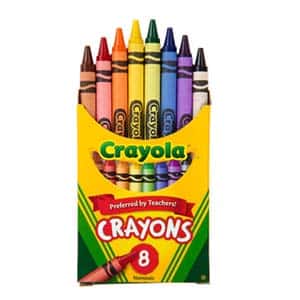
Although this may be true, crayons are opaque, and diamonds are crystalline in structure. Be that as it may, oh, let it be, let it be, wander down this page with me.
And when it's all said and done, you'll know more about diamond color from the brightest whites to the setting sun. However, please suspend whatever current beliefs and old notions you may have about diamond color.
At the same time, try to keep an open mind as you read the rest of this page. In which case, you will automatically begin to develop new understandings that will improve your perception of diamond color.
After all, the differences in body color between diamonds of different color grades are less noticeable than you might imagine. Be that as it may, we grade diamond color on the absence rather than presence.
In other words, it's time to put away your box of Crayola Crayons because those diamonds are not opaque objects. Under those circumstances, it's essential to realize that diamond color is mainly subjective.
Diamond Color Mastery in 33 Minutes:
In the next few moments, your comprehension of diamond color will improve dramatically. In the first place, you'll begin to understand how different lighting types affect your perception of diamond color.
After all, understanding that diamond color is simply a matter of perception will enable you to buy with confidence. Secondly, you will absorb a wealth of knowledge about diamond color by merely reading this article all the way through.
With that in mind, let's pretend that you and I are two people just sitting here enjoying a conversation. Throughout this course, your thoughts may wander to other things as they frequently do.
In which case, you will remember as much from this conversation as you do from most others. With that in mind, the most important thing to remember is that diamond color is strictly a matter of perception.
Now, Imagine Your Perfect Diamond:
Before we go much further, take a moment to visualize or imagine your perfect diamond. That can be whatever it is that's right for you based on your preferences.
With this intention, feel free to suspend those old thoughts and beliefs about different diamond color and clarity grades. The spectral bliss of this Black by Brian Gavin Diamond has nothing to do with it being colorless.
In which case, you can set the color grade aside for the moment and focus only on the sparkle factor. That's right, imagine all those vivid flashes of brilliant white and colorful sparkle dancing in front of your eyes.
Let your eyes soak in those fiery flashes of brilliant light that diamonds of this higher cut quality can only produce.
With that image in your mind, see that diamond color does not affect the sparkle factor. Be that as it may, three things might still affect Miss Muffet's decision about what color diamond to buy:
We're going to explore the latter in great detail, right after we cover the diamond color grading basics. But first, this is an excellent time to clear your mind of those old-world beliefs about diamond color. If you agree, then let the journey begin.
How to Grade Diamonds for Color:
In the first place, it's important to remember that we grade diamond color under laboratory conditions. In that event, the only light in the room is from the GIA Diamond Light.
In other words, we grade diamonds for color in a room that is otherwise pitch black. In comparison, you'll be looking at your diamond under real-world lighting conditions. In that case, can you guess the diamond color of this solitaire from James Allen?
We use sets of master stones for each spectrum on the GIA diamond color scale for accuracy purposes. The following video by the Gemological Institute of America (GIA) shows how to grade diamond color. Watch as the grader moves the diamond between the master stones to determine the best match.
GIA Diamond Color Grading Video:
Lighting Environment Considerations:
Consequently, you might want to pay particular attention to the lighting environment. After all, this video shows how lighting temperature affects our perception of diamond color.
You're probably beginning to see diamond color in a whole new light. In which case, you'll be glad to know that it's harder to see differences between color grades under standard lighting.
There is a reason why we grade diamonds for color in a pitch-black room! Under those circumstances, the sparkle factor is unable to distract us from the diamond color. Your diamond will also reflect all the other colors in the environment and make it more difficult to ascertain the diamond color.
The GIA Diamond Color Scale:
In the first place, the GIA diamond color grading scale only applies to white diamonds. In other words, the grading scale applies to diamonds that range in hue and saturation from colorless to noticeably yellow. The alphabetical color grades are as follows:
In that event, most people assume that buying a D-color diamond is the best choice. After all, it seems like diamond prices decrease as the color becomes more noticeable.
Although this may be true, even trained professionals like myself can't accurately grade diamond color from across the dinner table. Be that as it may, the sparkle factor of this Brian Gavin Signature diamond is visible from across the room!
It will be whether the diamond is D-color or K-color. With that in mind, the only thing people will be talking about is how much your diamond sparkles.
By the way, would you have guessed that this 3.094 carat, Brian Gavin Signature Cushion cut diamond is J-color? After all, it still faces up pretty white, even set in yellow gold.
The GIA Color Scale From D to Z:
People often ask me questions like:
In the first place, a jeweler named Robert M. Shipley created the Gemological Institute of America back in 1931. At the time, many retail jewelers were using the letters A-B-C to designate diamond color and clarity grades. Some brick and mortar jewelry stores still use this system:
Although this may be true, the GIA wanted to distinguish its grading standards from the rest of the world. With that in mind, Shipley created an entirely new grading system for the industry to follow.
Under the circumstances, the letters A, B, and C, are not used to describe diamond color or clarity. The letters A-B-C's previous use is why the GIA Color Scale begins with D-color and ends with Z-color.
Higher Color vs. Lower Color Diamonds:
The inner circle of the diamond industry describes D-E-F color diamonds as being higher in color. Secondly, we refer to L-M-N+ color diamonds as lower in color, which might be unfair and misleading.
After all, that implies that diamonds that exhibit any degree of warmth are less than desirable. Be that as it may, it's also true that Z-color diamonds will face-up warmer than D-color diamonds.
At the same time, it's kind of like saying that the moon is more desirable than the sun. After all, the moon appears to be much whiter and brighter in the midnight sky. In contrast, the hue and saturation of the sun are warmer and show a hint of yellow.
Cape Color Diamonds:
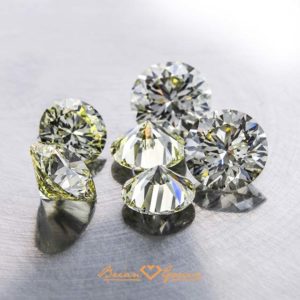
I like to say that Cape Series Diamonds from Brian Gavin sparkle like the sun. After all, they are warmer in color and exhibit those lovely summer hues that my mom loves so much.
Consequently, my mom has a summer skin tone and prefers diamonds that are warmer in hue and saturation. As a result, the diamond that adorns my mom's hand is M-color and rests on a yellow gold band.
Nevertheless, the diamond looks spectacular because of the sparkle factor, and people don't question the body color. With that in mind, it seems clear that your choice of diamond color is strictly a matter of personal preference.
Under those circumstances, some people will prefer diamonds that are cooler in tone. In contrast, other people will choose diamonds that are warmer in appearance.
In a moment, you will see that diamond color is a matter of perception. It will then be easier for you to choose the diamond in the most appealing color range.
Diamond Color Grading Chart:
No doubt you're familiar with those glossy Diamond 4Cs pamphlets that brick and mortar jewelry stores wantonly toss around. They always feature a "diamond color grading chart" printed on the paper. It usually like this one from Blue Nile:
Consequently, it's interesting how Z-color diamonds always look so yellow on these charts. After all, it's not like a Z-color diamond looks lemon yellow in real life. With this in mind, I urge you to remember that diamonds are not opaque like paper.
White diamonds within the spectrum of D-Z color are transparent crystals. With that in mind, diamond color is not as distinct as it appears on paper and printer's ink.
Be that as it may, the chart above is a fascinating interpretation of the GIA Color Grading Scale. After all, it runs backward from Z to D color instead of from D to Z color as intended.
Diamonds as White as Snow:
"The Snow Goose does not need to bathe to make itself white" (Lao Tzu), neither do white diamonds. In other words, the GIA Color Scale for white diamonds describes a spectrum of hue and saturation for white diamonds.
Nevertheless, I will pause momentarily to allow adequate time for that concept to sink in.
After which I'll ask you to take another look at how the GIA describes that spectrum of hue and saturation:
GIA vs. Blue Nle Diamond Color Scale:
Conversely, did you happen to notice how these descriptions differ from the ones that Blue Nile is using? In the first place, the GIA uses the terms faint yellow, light yellow, and yellow to describe the range of color that Blue Nile indicates as having noticeable color?
At the same time, Blue Nile is not necessarily wrong because K-color diamonds reflect a hint of warmth. However, I wouldn't exactly describe it as noticeable myself since it lacks intensity.
In this case, Blue Nile is lumping three classifications of color into one group. In terms of marketing to the masses, it's a linguistic approach that might have some merit. But the moronic marketing simplicity wreaks from the perspective of sound gemological practices.
What Is The Color White?
According to Wikipedia: "White is the lightest color and is achromatic (having no hue). It is the color of fresh snow, chalk, and milk and is the opposite of black. White objects fully reflect and scatter all the visible wavelengths of light. White on television and computer screens originates from a mixture of red, blue, and green light."
As shown on the left, Victor Canera Diamonds uses a color scale to represent diamond colors in their search options. They also present the scale in reverse order in the same fashion as Blue Nile.
Then Victor Canera presents the diamond clarity scale in the correct sequence below the color chart. Consequently, the fact that they show the GIA Diamond Color Scale in reverse order drives me batshit.
After all, there is a correct and logical order to certain things, and the alphabet is one of them! Be that as it may, I'm sure there is a logical reason for this, and it's probably because the price is more enticing.
Accurate Perception of Diamond Color:
Under the circumstances, I think you're going to enjoy this little experiment that will fine-tune your perception of diamond color. To begin with, think back to the Diamond Color Grading Chart provided above.
How much yellower did the Z-color diamond appear than the D-color diamond? Under the circumstances, I think you're going to enjoy this little experiment that will fine-tune your perception of diamond color.
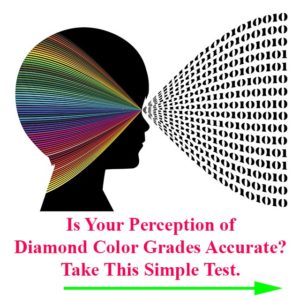
To begin with, think back to the Diamond Color Grading Chart provided above. How much yellower did the Z-color diamond appear than the D-color diamond?
Go ahead and drift back up the page and sneak a peek if you like because This is an Open Book Test.
Then, pick up a piece of plain white paper off your desk. Go ahead and raid the printer if necessary.
Hold the piece of paper up directly in front of your face and look through it at this picture.
How many colors do you see? The correct and most probable answer is none. After all, sheets of paper are not translucent like diamonds. For that reason, we know that most people's perception of diamond color is off. Feel free to invite your friends to try this experiment (try not to laugh).
Putting Pen to Paper:
Most diamond buyers do not have an accurate perception of diamond color. However, they base their decision on the paper and ink illustrations that the trade provides, so it's not their fault.
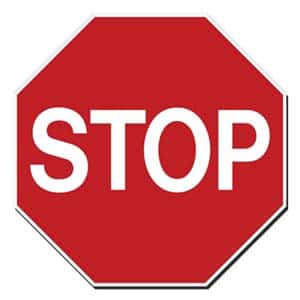
Of course, now you know that Diamond Color charts printed on paper have nothing in common with actual diamonds.
In the first place, the hue and saturation levels of the printer's ink on paper cannot accurately portray diamond color. It never has, and it never will because diamonds are translucent like fresh spring water.
For example, the Color RED on this page does not look the same as a red glass of Kool-Aid. In which case, paper and ink-based diamond color grading charts are not accurate. Now that we've agreed on that let's stop using them.
GIA Diamond Color Wheel:
This interactive GIA Diamond Color Grading Wheel is an improvement over those dusty old paper and ink illustrations. However, this is still not reliable for grading purposes.
After all, it is not an accurate representation of diamond color because these are not actual diamonds. Although this may be true, these types of illustrations may help you appreciate the subtle differences in hue and saturation.
However, you should be aware that this attempt to illustrate the differences between the 23 different color grades is still an illustration. The reality is that most people can not tell the difference between diamonds that are one or two color grades apart.
At least not without some coaching and perhaps a white background to create contrast. Of course, this will be even more difficult if you're looking at the diamonds in the face-up position.
You Ought To Be In Pictures:
You can no doubt see a distinct difference in the degree of hue and saturation between these diamonds. Tino Hammond's photograph shows the difference between E-K-Z color diamonds from a side profile.
Although this may be true, a photograph like this still shows the diamonds as opaque objects. In which case, your perception of color is going to be affected.
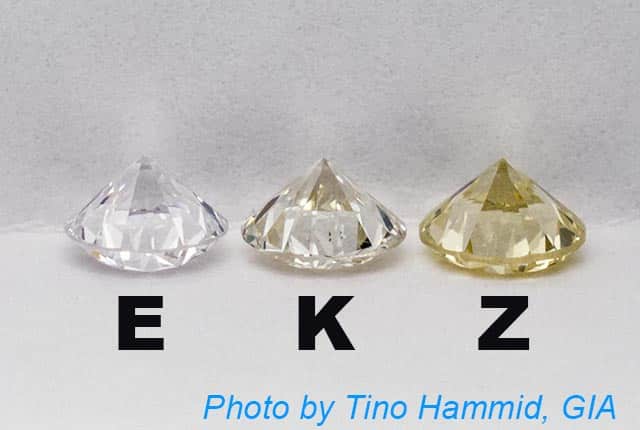
Photograph of E-K-Z Color Diamonds:
The three white diamonds in the photograph above are as follows:
Under these circumstances, it should be pretty easy to see the diamond color difference from a side profile. We grade diamonds from this vantage point because there is no sparkle to hide the color. In contrast, the color would be less evident in the face-up position.
The vivid and intense sparkle of a super ideal cut diamond will positively impact your perception of color. That's because the higher volume of sparkle will mask the body color in the face-up position.
With that in mind, think of light reflecting off the surface of a large lake or the ocean. In that instance, the water's surface is sparkling white, and you may not be able to judge the color accurately.
Although this may be true, for right now, merely focus on the color difference of those three diamonds above. The point of this exercise is to improve your perception of diamond color.
With that in mind, I'm showing you diamonds on opposite sides of the color spectrum. The difference will be less apparent between diamonds in the same range of diamond color, e.g., G-H-I-J near-colorless.
Perception ≠ Reality:
There is something special about that Z-color diamond that you are now ready to see. Begin by taking another look at the Z-color diamond above and only the Z-color diamond.
There is no need to focus on the E-color diamond nor the K-color diamond right now. For this experiment's purpose, try and ignore the differences in hue and saturation between those two. After all, this exercise is only about the Z-color diamond.
With that in mind, allow the Z-color diamond's hue and saturation to soak into your visual memory. Under the circumstances, you might want to close your eyes and imagine or visualize that Z-color diamond. Because the more you practice seeing diamond color, the more you will appreciate the subtle differences.
Think back to the illustration now that you can clearly see the Z-color diamond in your mind's eye. Then tell me, does the actual Z-color diamond in the photograph above look anything like the drawing?
In other words, does printer ink look anything like real life? On that note, does a photograph accurately portray real life either? Of course, the answer is no, and that is why we use master sets of natural diamonds to grade color.
Saturation of Diamond Color:
If you are beginning to think of diamond color as being fluid, you are right. After all, you have learned today that our perception of color changes depending on the situation.
The presence of other colors in the room and your surroundings can affect your perception. Simultaneously, the diamond color tends to be more noticeable when carat weight is more considerable.
Under those circumstances, the diamond color will seem more apparent in 2-carat than one-carat diamonds. That is because the saturation of color is more noticeable as the surface area becomes more substantial.
It isn't easy to ascertain this Brian Gavin Signature diamond's body color for that reason. After all, the lighting scenario and the sparkle make it impossible for us to make that determination. That is the exact thing that I want you to remember.
If we circle back to the Kool-Aid analogy above, you'll see a higher concentration of red in a drop of Kool-Aid that measures 8.60 mm in diameter. In comparison, you'll see less color in a diamond that measures only 6.50 mm in diameter.
For this reason, gemological laboratories like the AGS and GIA maintain different master sets for grading diamonds of various sizes.
Does Size Matter?
After all, you would not use a 1-carat diamond as the basis for determining the size of a 2-carat diamond. In the same fashion, you would not use a 5-carat diamond when grading a 3-carat diamond color.
Size matters, and there is no need to beat a dead horse. After all, if you've ever painted a wall (any color), then you understand the concept. After all, the wall's color will never look the same as it does on the paint swatch.
Consequently, you wouldn't use a one-carat diamond to determine the color grade of a two-carat diamond. Likewise, you would not use a five-carat diamond when grading the diamond color of a two-carat diamond. In that case, the diamond carat weight is taken into account when grading diamond color.
Cape Color Diamonds:
On the condition that you like warmer tones, you're going to love these Cape Series diamonds from Brian Gavin. After all, these diamonds sparkle like the sun and are perfect for people with summer skin tones.
Diamonds that are M-Z color are also known as Cape Color Diamonds. Consequently, that's because diamond color used to be described based on the country of origin.
Diamonds from the Cape Town region of South Africa were warmer in color. Therefore they were commonly called Cape Diamonds. Similarly, the terms Jager and River describe D-F color diamonds from that time in history. Likewise, Wesselton, Top Wesselton, and Top Crystal describe G-J color diamonds from that period.
Why are some diamonds yellow?
It's just a matter of simple chemistry. The presence of nitrogen is responsible for the yellow color exhibited by many diamonds. As little as one part per million is enough to make that K-color diamond pictured above faint yellow.
Congratulations Padawan!
Congratulations are in order because now you know the basics of diamond color grading. You've done a fantastic job of learning about the different color grades.
Under the circumstances, you should be able to buy a white diamond with total confidence now. In other words, you probably have a good idea of what range of diamond color you prefer.
Not to mention that you have a much better understanding of how other factors can affect the perception of color. Of course, there is much more to learn about the subject. As you continue to wander down this page, you may wonder about all those possibilities.
Given that repetition is the mother of skill, you should read this tutorial again and again. If you continue forth on the journey, you are bound to achieve Diamond Color Jedi Master's status.
Let the Games Begin:
You've learned a lot about diamond color up to this point. However, the reality is that we've only just begun to scratch the surface.
Although you now have a deeper appreciation for the slight differences in diamond color, there is more to learn.
At this time, you should recognize the GIA letter and word designations that describe each color grade. Plus, you know that our perception of diamond color on paper does not necessarily match reality.
Now, it's time to take things to the next level and explore diamond color grading nuances.
Blue Fluorescent Diamonds:
Watch this video from a client of Brian Gavin Diamonds, and your perception of diamond color will evolve to trade level.
The video below shows how different types of lighting can affect the perception of color. With that in mind, be sure to notice the incredible sparkle that Brian Gavin Signature diamonds display.
Watch closely and pay attention to how your perception of diamond color changes from moment to moment. And how the color of the diamond changes with exposure to each lighting environment.
Video of Blue Fluorescent Diamond Under Different Lighting Conditions:
You may want to watch this video more than once to appreciate the full effect. In the first place, notice how the lighting affects your perception of color. Watch closely as the color of the diamond changes from room to room.
Lighting Environments Shown:
The video above shows a Brian Gavin Blue fluorescent diamond as seen under the following lighting environments:
Appreciate the Sparkle Factor:
The more you watch, the easier it becomes to appreciate how lighting affects your diamond color perception. Remember how the Brian Gavin Signature diamond sizzles in every lighting environment?
Picture those bright, bold, vibrant flashes of light. Then, imagine what it must be like to hold that diamond in your hand and see all that sparkle for yourself. Isn't that what you want in a diamond?
Light performance has nothing to do with diamond color because that is a product of optical precision. That is why diamond connoisseurs prefer Brian Gavin Signature Diamonds.
FTC Rule 28 ~ Blue White Diamonds:
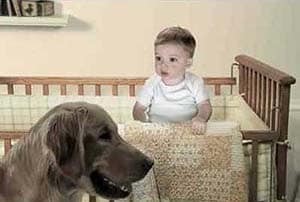
Believe it or not, there was a point in time when "Blue White Diamonds" were all the rage. As a matter of fact, it was right around the time when our grandparents were enjoying the roaring twenties.
Specifically, the term refers to D-E color diamonds with higher concentrations of blue fluorescence. Such as D-E color diamonds that exhibit strong to distinct blue fluorescence. Although this may be true, it's worth nothing that this practice is frowned upon in this establishment.
Rule 28 of the Federal Trade Commission:
Misuse of the term blue-white: "It is unfair or deceptive to use the term "blue-white" or any representation of similar meaning to describe any diamond that under normal, north daylight or its equivalent shows any color or any trace of any color other than blue or bluish."
Blue White Diamonds:
"Blue White Diamonds" I wonder where people would get a crazy idea like that? After all, can you imagine some disreputable retail jeweler using such a ridiculous term?
Of course, you can because it sounds more intriguing than saying this D-color diamond exhibits strong blue fluorescence. Even I find the idea of blue-white diamonds fascinating because that phrase sounds so rare and mysterious that it paints such a beautiful picture in my mind.
Be that as it may, many retail jewelers did try to take advantage of people by misusing the term blue-white. Blue-white diamonds were so popular that there was a shortage of them.
However, this was not a problem because jewelers just started showing their diamonds under blue light bulbs. Hence Rule 28 of the Federal Trade Commission.
Pause for dramatic effect. "That's right, folks, this blue-white diamond is extremely rare and looks brighter and whiter than other diamonds."
Although that may be true, diamonds with blue fluorescence look perfectly normal under standard lighting. The only reason why this Brian Gavin Blue Fluorescent diamond looks blue in this photograph is that it's under black light.
Consequently, I am NOT suggesting that this Brian Gavin Blue Signature Diamond is a blue-white diamond. I am sarcastically using old-world jeweler-speak to describe diamonds with blue fluorescence.
Intensities of Blue Fluorescence:
White diamonds exhibit varying degrees of fluorescence from negligible to distinct blue. In the light of day, they all look pretty much the same. With that in mind, the degree of blue fluorescence is primarily an identifying characteristic.
The degrees of blue fluorescence are as follows:

GIA Diamond Blue Fluorescence Intensity Chart.
Generally speaking, I do not recommend that you buy a diamond with very strong to distinct blue fluorescence. Such a high degree of fluorescence can make a diamond look cloudy or foggy under certain conditions.
Although that may be true, the I-color diamond that Brian Gavin cut for my wedding ring had distinct blue fluorescence. I asked him for a diamond with those characteristics, and it was stunning!
Is Blue Fluorescence Good or Bad?
You might be wondering what impact does fluorescence has on the appearance of a diamond?
"GIA studies show that for the overwhelming majority of diamonds, the strength of fluorescence has no widely noticeable effect on appearance. The GIA Fluorescence Study found that the average person could not make a distinction between a diamond with fluorescence and a diamond without."
-- Excerpt from GIA Blog: Understanding Diamond Fluorescence. May 09, 2012
Most people in the industry have never read the GIA Study on Blue Fluorescence. If they had, then there would be less misinformation about blue fluorescence.
According to the study, blue fluorescence negatively affects less than 2% of gem-quality diamonds. In other words, 98% of gem-quality diamonds look perfectly fine. With that in mind, it's reasonable to assume that blue fluorescence is a positive trait.
After all, it is likely to improve your perception of diamond color by filtering out some of the yellow undertones. Simultaneously, the small percentage of over-blue fluorescent diamonds that exhibit negative traits are quite rare.
How Does Fluorescence Affect Diamond?
Generally speaking, blue fluorescence in white diamonds serves to improve your perception of diamond color. Because the blue fluorescent molecules help filter out any yellow undertones that may be present in the diamond.
Blue fluorescence only has an effect when the molecules are excited by the influence of ultra-violet light. That is one of the reasons why you might decide to purchase a Brian Gavin Blue fluorescent diamond.
The most compelling evidence of this is my decision to purchase a diamond with distinct blue fluorescence for myself. Be that as it may, I don't recommend that intensity of fluorescence for most people.
After all, it can be a bit much unless you're the type of person who loves blue fluorescent diamonds. However, I like the neon blue effect that exposing blue fluorescent diamonds to black light creates.
Consequently, there is a nice discount applied to blue fluorescent diamonds. In the first place, it has nothing to do with the effects of blue fluorescence. Instead, it has to do with a public misconception about the impact of fluorescence. God bless people who don't understand blue fluorescence because that makes the diamonds I like more affordable.
Blue Fluorescence Filters Yellow:
Excerpt from LiveScience.com: "Red-green and yellow-blue are the so-called "forbidden colors." Composed of pairs of hues whose light frequencies automatically cancel each other out in the human eye, they're supposed to be impossible to see simultaneously."
Does Fluorescence Make Diamonds Cloudy?
Some people think that fluorescence makes diamonds look cloudy. Upon further investigation, they will often claim that blue fluorescence makes their diamond look lavender blue.
It seems like this optical illusion only occurs when they look at their diamond in direct sunlight. Under those circumstances, they wrongfully assume that the blue fluorescent molecules are being excited by the presence of ultra-violet light.
Sometimes people tell me that the same thing is happening with their non-fluorescent diamonds. In that case, they are sure that the gemological laboratory did not grade the fluorescence accurately.
Ah, I'm guessing that I have your full attention now. However, what those people assume is happening is not the cause. What is happening is much simpler and somewhat more amusing because it's an optical illusion.
Why Diamonds Look Bluish-Grey in Sunlight:
The reason why diamonds look cloudy in direct sunlight has nothing to do with fluorescence. Your eyes will adjust to protect themselves from being damaged by a bright light on the condition that you are human. Notice how the diamonds in this picture look blue?
When you look at a diamond in direct sunlight, the sparkle factor is nothing short of intense. In that case, your eyes adjust to protect themselves, and your diamond appears to be bluish-grey.
Under those circumstances, people tend to mistake the lavender-blue hue for the effect of blue fluorescence. However, it's nothing of the sort, and that is why non-fluorescent diamonds also look bluish-grey in direct sunlight.
50 Shades of Diamond Colors:
Now that you know that color does not affect Light Performance, you can consider a broader range of options. After all, you understand that the perception of color changes from room to room.
Under those circumstances, it's fair to say that there are 50 Shades of Diamond Colors. The color of your diamond is not static like a photograph. In other words, the appearance of your diamond is fluid and will change with each reflection.
Now, that is an idea that you might want to ponder for some time. You can appreciate that phenomenon every time you see how your diamond sparkle changes with the lighting.
Diamond Graders Do It In the Dark:
In the light of this discussion, it might surprise you to discover that diamond graders do it in the dark. In other words, we spend most of our time locked away in a pitch-black room playing with little rocks.
All right, technically diamonds are minerals and not rocks, but we're still tucked away in a dark room like mushrooms. The GIA Diamond Light is the primary light source in a gemological laboratory.
Of course, there is also a little bit of light coming from the microscopes and a monitor. Otherwise, things are pretty dark, which helps us discern the subtle differences between the color grades.
This photograph from the GIA Gemology Course will give you a better idea of what this looks like:
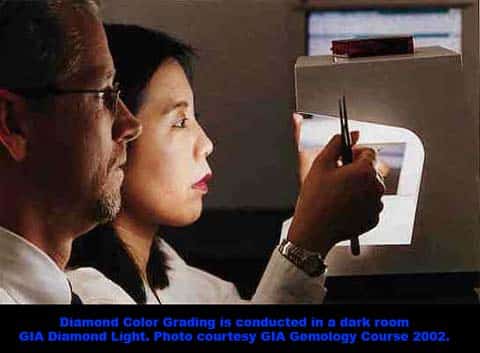
Grading Diamond Color in the GIA Laboratory.
As shown in the photograph above, the woman is holding a white tray in her left hand. That is a diamond sorting tray that provides a neutral background.
When grading diamonds for color, they sit on a white tray with the bottom culet pointing up. From this vantage point, we examine the diamonds from the side profile.
And compare them with master stones of previously graded diamonds in the same spectrum. In this manner, we can ascertain the range of hue and saturation and determine the color grade.
How to Grade Diamond Color:
When we grade diamonds for color, we look at them from a side profile, as shown here. The graders at the AGS Laboratory determined the color grade of this 1.413 carat, G-color, VS-1 clarity, Brian Gavin Signature diamond by comparing it with a set of master stones.
They use a GIA Diamond Light like the one shown above. In that case, the only light in the room is from the grading equipment. After all, any other light source in the room might influence the graders' perception of color.
The temperature of the light can also influence the color grade. That is why the GIA Diamond Light and microscopes use specially designed lightbulbs that are color corrected.
With that in mind, have you ever taken the time to think about the temperature of light? After all, it's rather interesting to think about how different light types can be cool or warm.
In other words, the color of light can be cool or warmer in tone. As a matter of fact, in the lighting industry, this phenomenon is known as Correlated Color Temperature (CCT). We'll talk more about that in a minute.
Since diamonds will reflect the color of our clothing, diamond graders tend to wear neutral tones. In other words, we try to wear clothing that is black and white. With this in mind, you will appreciate all the beautiful colors that your diamond exhibits.
Lighting Temperature:
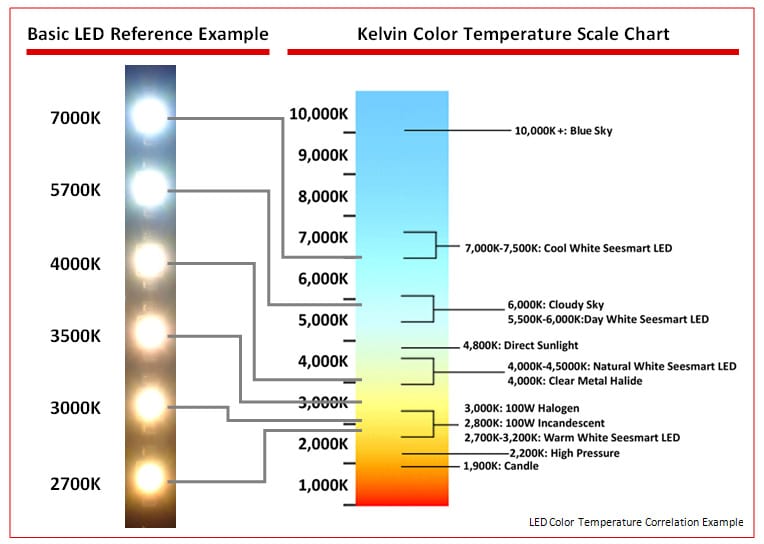
In the first place, I "borrowed" this Kelvin Lighting Temperature Chart from See Smart LED. Secondly, this chart intends to show what lighting temperature is best for different purposes.
As you can see, higher temperature lights produce cooler tones that appear to be blue. In contrast, lower temperature lights have warmer tones that look more yellow, orange, and red.
If you've ever stood under the blazing hot lights of a jewelry showroom, then you might see the connection. After all, the halogen lighting intends to make diamonds look brighter and whiter.
Those lights are so bright that they'll make frozen spit look good. By the way, that's not crude; it is a standard industry reference to the I-3 clarity diamonds.
Although this may be true, I want you to focus on the differences in lighting temperature. Because the temperature of the light will affect your perception of color as you move from room to room. Now you are ready to learn about the Disneyland Diamond Effect because you know how different lighting types affect appearance.
The Disneyland Diamond Effect:
In the first place, the Disneyland Diamond Effect is a concept taught to me by my mentor Brian Gavin. Secondly, it's just a playful way to describe the lighting environment you'll see in most jewelry stores.
You know that Walt Disney is famous for creating illusions built upon a fairytale. Practically all jewelry stores use 3000-watt halogen lighting to create the illusion that their diamonds look good.
Under those circumstances, crushed rock quartz looks impressive when you pump that much light into it. That is why so many people end up buying diamonds that perform poorly in the real world.
There's More to This Than Meets the Eye:
Although that may be true, this is not the only trick jewelers employ to create the Disneyland Diamond Effect. Blue dichromatic filters are also used in conjunction with the lighting and artificially improve diamond color. In other words, jewelers use lighting with blue filters because it cancels out the yellow.
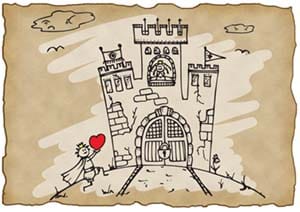
Oh, Chris Angel, eat your heart out because jewelers might be the best illusionists of all time! After all, they can turn yellow diamonds into white with a simple flick of the wrist!
Of course, it's easy to explain the magic behind the illusion. After all, the trick turns on a simple switch, a few halogen lights, and a blue dichromatic filter.
Influences on Diamond Color:
Now, you are familiar with how the diamond color changes with exposure to different light sources. You also know how lighting temperature influences your perception of diamond color. Next, we're going to look at some other things that factor into the equation:
The structure of a diamond consists of facets that act like tiny mirrors. With that in mind, your diamond is going to pick up on everything in the near vicinity. Then, it is going to reflect all of that splendor at you to enjoy. In which case, the diamond color is changing continually as a direct reflection of the environment.
Mirror, Mirror On The Wall:
"What's the best diamond color of them all?"
Of course, we're all familiar with the story of Walt Disney's Snow White. There is an interesting correlation between "the fairest of them all" and D-color diamonds. After all, everything is a matter of perception, including how we visualize snow white.
With that in mind, a few years ago, my late-wife Robin called me into the grading room where she was grading a D-color diamond that should have been bright white.
However, this particular diamond looked more like J-color to Robin, and she couldn't believe it. After all, how could the diamond graders at the GIA Laboratory make such an obvious mistake?
"This is not a D-color diamond!" said Robin. "Just look at it, it's closer to J-color, and it might even be warmer than that." Consequently, the D-color diamond she was holding in tweezers was showing some warmth.
The Case of the Yellow D-color Diamond:
The case of the yellow D-color diamond began to unravel as Robin exclaimed: "This is completely unacceptable."
At which point, I began to laugh, and as it turns out, that is not an appropriate response. Because the next thing I knew, I was the focal point of Robin's wrath.
Be that as it may, Robin's outburst didn't last for long because I was pointing my finger at her shirt. Given that fact, Robin looked down at the optic yellow blouse that she was wearing.
The issue with the D-color diamond immediately became apparent since the yellow shirt was coloring her perception.
That kind of situation is the reason why diamond graders wear neutral color clothes. In other words, we run around the diamond grading laboratory dressed like Men In Black (or women if you prefer).
Should Diamonds Be Set in White or Yellow Gold?
The color of the prongs or setting is going to influence the color of your diamond. After all, the color of the metal touching the diamond's edge will reflect throughout the stone.
In the first place, the color of the prongs/setting can affect our perception of color. It can affect the color of a diamond by as much as one full grade. In other words, setting an H-color diamond in white metal prongs might make it seem more like G-color.
Whereas setting the same H-color diamond in yellow or rose gold prongs will make it look more like I-color. Putting a diamond in platinum or white gold will make it look whiter and brighter, to put it differently.
While setting that diamond in yellow or rose gold will make it seem warmer in tone. You can see how the color of these halo settings from Brian Gavin affects the diamond color.
First, notice how the color of the center stone changes to reflect the settings' color. In the first place, the diamond on the left faces up bright and white.
In comparison, the diamond in the middle looks a little warmer due to the yellow gold's effects. So does the diamond on the right because the setting is 18k rose gold.
Effect of Alloy Type on Diamond Color:
In the first place, I want you to know that the color of the ring is not a critical factor. Only the color of the metal that touches the edge of the diamond will impact the color.
How Setting Color Influences Diamonds:
Most jewelry appraisers and independent gemologists agree that the setting's color that touches the diamond's edge can affect our perception by about one color grade.
In that case, assume that you're buying this 2.117 carat, H-color, VS-2 clarity, Brian Gavin Blue fluorescent diamond. It's probably going to face-up bright and white on the condition that it exhibits medium blue fluorescence.
However, it's going to look even whiter if you set it in platinum or white gold prongs. At the same time, it will still face-up pretty white set in yellow gold or rose gold. Consequently, I think that people worry far too much about the color of their diamonds.
After all, it's the degree of optical precision and proportions that determine the sparkle factor. In that case, this diamond will be outstanding due to the higher degree of optical precision that Hearts and Arrows diamonds exhibit.
Can You See Yellow in I-color Diamond?
You might detect a hint of warmth in an I-color diamond. Of course, your ability to do so will depend on the lighting circumstances. The color of the setting will also affect the appearance of the diamond. While you might be able to detect a hint of warmth in a diamond up close, the odds are that you won't see it from across the dinner table.
What Is The Best Color Diamond for an Engagement Ring?
You might like a particular car color in the same way that you may prefer different spectrums of diamond color. Under those circumstances, you should look at other diamond colors to determine your preference:
Diamond Color Recommendations:
If you are looking for an excellent middle ground, then I would buy an F-G color diamond. After all, it's going to face-up bright and white without breaking the bank.
Most people can not see the difference between D-F color when mounted in a ring. Although this may be true, I selected an I-color diamond for my wedding ring.
I could afford a larger diamond under those circumstances, and carat weight is more apparent than color. With this in mind, deciding what color diamond to buy is mostly about finding the right balance of characteristics.
Since most people cannot tell the difference between a color grade or two, it's mostly about deciding on the range. In other words, buy a colorless diamond if you need it to be bright white.
Or, buy a near-colorless diamond if you want it to face-up relatively white in a ring. Likewise, you should buy a slightly warmer diamond if that is your preference because it's all relative.
The Brightest Whitest Diamonds:
Which of the following diamonds would you say is D-color? E-color? F-color? This picture shows one of each diamond color D through F:
In this case, the diamonds are in the following order from left to right:
The situation above might be the type of challenge that you face while trying to buy a diamond. After all, it seems to me that the F-color diamond on the right is the brightest and whitest. Then the D-color diamond on the left seems like the next best option. Finally, the F-color diamond in the middle looks like it's exhibiting a hint of warmth.
Factors of Perception:
However, that would not be the case if you were looking at these diamonds under laboratory conditions. And therein is the rub because you can't use these diamond clarity photographs to judge body color.
After all, that is not their intended use, and they are not color corrected for that purpose. Several factors will affect your perception of color in a photograph:
Of course, I know you think that a picture is worth a thousand words. However, they aren't that helpful when it comes to judging diamond color. Although that may be true, it won't stop us from using them to become more familiar with ranges of color.
Examples of G-H-I Color Diamonds:
The screenshot below shows three James Allen True Hearts diamonds as seen from a side profile. In this case, the diamonds are in the order of G, H, and I-color from left to right:
In the first place, I want you to focus more on the differences in hue and saturation rather than color. After all, when we grade diamond color, we are looking for an absence of color.
However, when we talk about diamond color, people tend to think more about color than less. In other words, people feel that diamonds further down the scale have more color.
Although this may be true, what we're looking at are differences in hue and saturation. With that in mind, do you see how the D-color diamond (above left) has less saturation of color?
Whereas the H-color diamond in the middle shows a little more? And the I-color diamond on the right shows a little more than that? Of course, to be technically correct, we would say that the G-color diamond has less color than the rest.
Changing Your Perspective:
Now, let's take a look at the same diamonds from the face-up vantage point. After all, that's how you're going to be looking at our diamond engagement ring.

G-H-I Color Comparison James Allen True Hearts Diamonds.
In the first place, notice how much harder it is to ascertain the difference in color in the face-up position. It's pretty difficult to detect slight differences in hue and saturation. In this case, these James Allen True Hearts diamonds are in this order from left to right:
What If the Clarity Photograph Looks Yellow?
In the same fashion as before, remember that these images' intent is not to judge diamond color. Their purpose is to help you identify the clarity characteristics. However, they also serve to provide you with an idea of how evenly light may be reflecting throughout the diamonds.
Now, did you notice anything about the photo-grey background behind the James Allen True Hearts diamonds above? Such as how it shows varying degrees of hue and saturation in every shot.
That is one of the reasons why you can't rely on these images to judge diamond color. You should not use these images to try and evaluate the sparkle factor for the same reason. The lighting conditions in the room are always changing, so rely on the labs to grade color. Don't try to judge diamond color off of a photograph.
J & K-L-M Faint Yellow Color Diamonds:
In the first place, you might be beginning to realize that I like to push the boundaries that define things. That's why I am clumping J-color and K-L-M diamonds together here.
Never mind the fact that J-color is near-colorless and K-L-M color diamonds are faint yellow. Oh, the inhumanity of it all. Can you ever forgive me for this bold and terrible act?
But, the thing is that from my perception, J-color is a wee bit warmer than I-color (as it should be). However, in such a way that it seems closer to K-color to me.
With that in mind, I tend to clump J-color diamonds into the faint-yellow spectrum along with K-L-M color diamonds. I think that Sir Robert M. Shipley should have drawn the line between "colorless" and "near-colorless" diamonds like this:
Of course, nobody at the GIA cares what I think. In that case, the GIA isn't going to adjust the color scale on my account. Consequently, some diamond dealers find my selection criteria and production standards to be unreasonable. Shocking, I know.
Do J Color Diamonds Look Yellow?
In the first place, I think it's reasonable to expect J-color diamonds to exhibit a hint of warmth. That is true even though they may have the right proportions and show a higher optical precision degree.
Although this may be true, it seems like a lot of my peers in the diamond industry disagree with my opinion. After all, they're always telling people that their diamonds' higher cut quality makes them look whiter and brighter.
The reality is that there is a bit of truth in both our vantage points. After all, the proportions and higher degree of optical precision will produce more virtual facets within the diamond.
That will produce more sparkle, and that sparkle will be more vivid and intense. The higher volume of sparkle will also make it more difficult to ascertain the body color.
Sparkle Factor Masks Body Color:
With that in mind, you will likely perceive a super ideal cut diamond to be brighter than a standard ideal. After all, the broad-spectrum sparkle will distract your eyes from focusing on body color.
However, that does not mean that you won't see the color if you shade the diamond from the light. In which case, you will be able to judge the body color more accurately. Under those circumstances, you might be able to detect a hint of warmth in a J-color diamond.
For example, if the diamond is in a yellow gold mounting like this 3.09 carat, J-color, VS-2 clarity, Brian Gavin Signature Cushion. In that case, it's going to face-up closer to L-color because it reflects the yellow gold color.
Can J-color Diamonds Look White?
Given the explanation above, you know that a J-color diamond will exhibit a hint of warmth. At the same time, it's probably going to face-up whiter than you think if it's cut to a higher standard.
With that in mind, if you're going to buy a J-color diamond, then buy a Brian Gavin Signature diamond. After all, it takes a higher degree of optical precision to produce a hearts and arrows pattern this precise.
In the first place, the higher degree of optical precision will produce more virtual facets within the diamond. Because of that, the broad-spectrum sparkle factor will be more vivid and intense.
In other words, a super ideal cut diamond is going to face-up brighter and whiter than a standard ideal with the same proportions. At the same time, remember that the lighting environment also factors into the equation.
I-color vs. J-color Super Ideal Cut Diamonds:
It never ceases to amaze me when people ask me something like this: "Will this J-color face-up whiter than this I-color Brian Gavin Signature diamond?"
After all, we're talking about two Brian Gavin Signature diamonds that reflect the same degree of precision. Under those circumstances, the I-color diamond has to face-up whiter than the J-color diamond.
After all, it's one color grade whiter and brighter than the J-color diamond. From a logical perspective, the lower color diamond can't face-up whiter than a higher color diamond.
There is no way that the J-color diamond will face-up whiter, even in the darkest corner of the multiverse. Although this may be true, I know the reason why people ask me these sorts of questions.
After all, they're trying to judge diamond color from the high-resolution clarity videos. Trust me when I tell you that this is a recipe for disaster and will only lead to confusion.
Diamond Color Money Saving Hack:
You can save a little money buying a J-color diamond and set it in white metal prongs. In that event, it's likely that the J-color diamond will face-up closer to I-color.
However, setting an I-color diamond in white metal prongs will have the same effect. Look at how white this 2.05 carat, I-color, VS-2 clarity, looks in this platinum petite pavé setting from Brian Gavin.
However, if you set the I-color diamond in yellow or rose gold prongs, it will look more like J-color. In which case, the J-color diamond set in white metal prongs might look a little whiter.
Of course, you probably realize that I'm messing with you a bit, right? But, seriously, how else do you expect me to answer these types of questions?
How Much Does Diamond Color Affect Cost?
In the first place, most people have difficulty discerning the difference between one or two color grades. Especially within the realm of super ideal cut diamonds because the sparkle factor is so impressive. With that in mind, you can save a lot of money by dropping down a few color grades.
Here's an example of that principle at work:
Under the circumstances, how much of a color difference do you see between these three diamonds? There is going to be a visible difference between the D-I color diamonds. Considering that these diamonds' sparkle factor is practically the same, I think you might appreciate the difference in cost more.
AGS vs. GIA Diamond Color Grades:
In the first place, I'm going to assume that you are familiar with the AGS and GIA gemological laboratories. After all, they are the leading diamond grading laboratories in the United States.
Their diamond grading reports well-known throughout the world. Be that as it may, the HRD Belgium is also extremely popular in Europe. I won't even consider a diamond that any other gemological laboratory grades.
That is to say that other gemological laboratories do not seem to grade to the same standards. With that in mind, I suggest you limit your search to diamonds graded by the AGS, GIA, or HRD gemological laboratories.
Diamond Grading Certificates:
Contrary to popular belief, the AGS, GIA, and HRD gemological laboratories do not issue diamond grading certificates. Instead, they provide diamond grading reports that reflect the diamond characteristics at the time of grading. To be clear, those gemological laboratories do not certify anything, and a statement to that effect appears on the back of the diamond grading report.
AGS vs. GIA vs. HRD Belgium:
In the first place, the AGS, GIA, and HRD laboratories grade diamond characteristics comparably in my experience. The grading standards are so similar that I don't have a preference between them.
In other words, they seem to grade carat weight, color, and clarity the same. However, there are distinct differences in the criteria for their overall cut ratings. With that in mind, I rank them in this order of preference:
- 1AGS Ideal-0 cut diamonds.
- 2GIA Excellent cut diamonds.
- 3HRD Excellent cut diamonds.
The AGS Lab Is Top Dog:
We prefer the Light Performance grading platform from the AGS Laboratory. After all, they are the only lab using Angular Spectrum Evaluation Tool (ASET) to grade light performance.
If you're looking for a diamond that exhibits the best sparkle factor, you should insist on ASET. I would not settle for anything less than the Advanced ASET from the AGS Laboratory.
Unfortunately, most diamond dealers are unwilling to subject their work to the Light Performance grading platform's scrutiny. Because the insight that ASET provides tends to reveal the inconsistency of the cut quality.
As a matter of fact, at the time I'm writing this article, Brian Gavin is the only cutter to adopt Advanced ASET. Be that as it may, it's not surprising that he is willing to provide you with that kind of insight.
After all, Brian Gavin is the only diamond cutter globally with a patent for maximizing light performance in the modern round brilliant cut diamond.
GIA Alphabetical vs. AGS Numerical Systems:
As can be seen, the grading standards of the GIA and AGS are practically identical. The AGS Laboratory is the brainchild of Peter Yantzer, the former director of the GIA Laboratory.
With that in mind, I do not have a preference between the two laboratories. Be that as it may, the GIA uses an alphabetical system while the AGS uses a numerical one.
Consequently, the differences between the grading platforms can be a bit confusing at first glance. With that in mind, the AGS Laboratory provides a cross-reference chart on their reports:

AGS to GIA Diamond Color Grading Scale Conversion Chart.
This reference chart shows the relationship between the AGS and GIA grading platforms. As you can see, the AGS numerical system is on the top row, and the GIA equivalent is on the bottom. In that case, a D-color diamond on the GIA grading scale is equivalent to a 0.0 at the AGS.
Likewise, an F-color diamond on the GIA diamond color grading scale is equivalent to a "1.0" on the AGS diamond color grading scale. However, it's worth noting that the AGS numerical based system begins with 0.0 and ends with 10. In which case, the AGS Laboratory considers anything warmer than X-color to be fancy yellow.
Is AGS or GIA More Accurate?
Occasionally, somebody will tell me that their jeweler says that the GIA grades color more strictly than the AGS Laboratory. Upon further questioning, it seems like the jeweler is some old dinosaur who knows not a lick about light performance.
They're usually trying to pawn off second rate dinosaur dung with undesirable proportions. In which case, their attempt to steer you away from the Light Performance grading platform of the AGS Laboratory is not surprising. After all, the vast majority of standard ideal cut diamonds will not fare well under those conditions.
Take this 1.07 carat, I-color, VS-2 clarity, GIA Excellent cut round diamond from Blue Nile, for example. In the first place, the pavilion angle of 40.8 degrees should produce a high volume of light return.
Secondly, the 35-degree crown angle should create a virtual balance of brilliance and dispersion. However, the proportions of the diamond are only one piece of the puzzle, and that's why it's leaking light:
The GIA Excellent cut diamond shown above has moderate to heavy light leakage occurring under the table facet. That's what the light pink transparent sections indicate in the ASET and Ideal Scope images. At the same time, it explains why the table facet looks so dark in the clarity photograph.
Does GIA or AGS Grade Color Better?
Only the AGS Laboratory grades diamonds for light performance, and that might be why most jewelers prefer the GIA. Under the circumstances shown above, I can only imagine that it's easier to sell GIA Excellent cut diamonds.
After all, most people are likely to see the Excellent cut grade and think it is good enough. Of course, you won't be one of those people because you know the difference that optical precision makes.
At the same time, you might still wonder whether the AGS and GIA laboratories see D-color the same way. In other words, will a D-color diamond graded by the GIA get a 0.0 rating from the AGS or vice versa?
In the first place, it's important to remember that each color grade represents a range of hue and saturation. At the same time, diamonds are color-graded by human eyes under laboratory conditions. However, the human part of the equation is subject to influence by outside factors.
Not the least of which are the effects of human emotion, blood sugar levels, caffeine consumption, and fatigue. It's reasonable that two diamond graders might see things the same or slightly different under those circumstances.
In that case, a diamond might get a D-color rating one day and E-color the next from the same person. Especially if the diamond is "sitting on the fence" between the two color grades.
Splitting Hairs:
In the first place, I recognize that what I'm about to say is likely to blow your mind. However, in the overall scheme of things, one color grade difference is a moot point. After all, you're going to be looking at your diamond from the face-up vantage point. In which case, you should be more concerned about the sparkle factor than the color grade.
Most people can't see the difference between one or two color grades, especially in the face-up position. With that in mind, whether the lab grades a diamond D or E color is of little consequence because you're not likely to see the difference.
With that in mind, what we're looking for is a reasonable amount of consistency. It's one thing for a D-color diamond to be graded E-color, but quite another for it to be F-color. I understand that some people might find this concept disturbing. However, I'll put your mind at ease now that the foundation is in place.
Putting AGS vs. GIA to the Test:
In the first place, there are a lot of rumors and speculation floating around about which laboratory grades more accurately. Not only that, but you'll run across claims that one lab grades color or clarity more strictly than the other.
I've heard that the GIA is stricter on grading diamond color. At the same time, the AGS is supposedly more stringent on diamond clarity. Be that as it may, I've also heard the exact opposite, and nobody is offering up any proof.
In other words, it's mostly just posturing in an attempt to push their agenda forward. With that in mind, you'll find that the position assumed depends on the nature of their business.
In that case, you'll find that most people selling standard ideal cut diamonds suggest that the GIA is the best. In contrast, diamond cutters like Brian Gavin prefer the AGS Laboratory because of the light performance grading platform.
Why the GIA Does Not Use ASET:
Since the Angular Spectrum Evaluation Tool (ASET) is proprietary to the AGS Laboratory, this is where the GIA falls short. After all, the entirety of the GIA system is proportions-based and allows for a lot of leeways.
Keep in mind that the proportions are only one piece of the puzzle. You still need ASET and Hearts & Arrows Scope images to judge light performance.
Although this may be true, most people buying diamonds fail to see how the GIA falls short. At the same time, those of you buying from Brian Gavin benefit from the insight provided by Advanced ASET. As shown on the left, there is not one but two ASET maps on the lab report.
Dual Certification*
Given the debate over whether AGS grading is more reliable than the GIA and vice versa, you might wonder about the possibility of sending your diamond to both labs for dual certification. After all, you might think that it makes sense to pay for a second opinion under the circumstances.
In the first place, I need to set the record straight by pointing out that there is no such thing as dual-certification. After all, the gemological laboratories do not certify diamonds; they grade them and issue a report, not a certificate.
The only "gemological laboratories" that I see issuing "diamond grading certificates" are second-tier labs. In other words, the only labs issuing certificates are the ones that don't seem to be able to grade anyway.
By the way, if you think I'm overly harsh, just Google EGL Diamond Lawsuit. Although that may be true when we submit diamonds for dual grading, the reports are conclusive most of the time.
In other words, the lab reports indicate that the color and clarity grades are practically identical. However, the measurements will always be slightly different because of how the labs report the numbers.
The AGS reports an average of eight measurements per facet section. In contrast, the GIA averages the same way and then rounds them off to the nearest half a degree and as much as five percent. I'll pause for a moment to let that last sentence sink into the depths of your mind.
The two laboratories also measure girdle thickness and lower girdle facet length differently. Plus, the GIA grades fluorescence from a side profile while the AGS evaluates it in the face-up position. For the record, I prefer the methodology behind how the AGS does things.
AGS/GIA Dual-Graded Diamond:
The date of submission to the AGS Laboratory (AGSL) for this Brian Gavin Signature diamond is December 09, 2013. The diamond grading report number is AGS #104068744001, and you can verify the details using AGS Report Check.
The date of submission for the same diamond to the GIA Laboratory is February 27, 2015. In this case, the report number is GIA #2145946424, and you can verify the details using GIA Report Check.
AGS Specifications:
GIA Specifications:
Under the circumstances, I think we can both agree that the AGS and GIA grades are comparable. The two laboratories concur on all the essential characteristics. In other words, both labs issued the same grades for the color, clarity, and carat weight.
Notice that the diamond was sent for grading by the AGSL and then the GIA for grading. In that case, those who claim that the GIA is stricter than the AGS are mistaken.
Here's Another Example:
In this case, the submission date to the GIA for this Brian Gavin Signature diamond is December 02, 2019. The GIA diamond grading report number is GIA #2337613526, and you can verify the details using GIA Report Check.
The date of submission to the AGS Laboratory (AGSL) is December 17, 2019. The diamond grading report number is AGS #104109577006, and you can verify the details using AGS Report Check.
AGS Specifications:
GIA Specifications:
As shown above, this Black by Brian Gavin received the same overall grades from the AGS and GIA. Except for slight differences in some of the measurements. As you will recall, the two labs average the measurements differently, so that makes sense.
EGL vs. GIA vs. AGS Graded Diamonds:
Many trade members think that the European Gemological Laboratory (EGL) is a second-tier laboratory. In other words, they don't believe that EGL grading standards are comparable to AGS and GIA. Consequently, I fall into that group and prefer diamonds graded by the AGS, GIA, or HRD gemological laboratories.
On September 09, 2014, the JCK Magazine reported, "RapNet Bans EGL Reports from Trading Network." That means that the largest Multiple Listing Service (MLS) prohibits diamonds with EGL diamond grading reports.
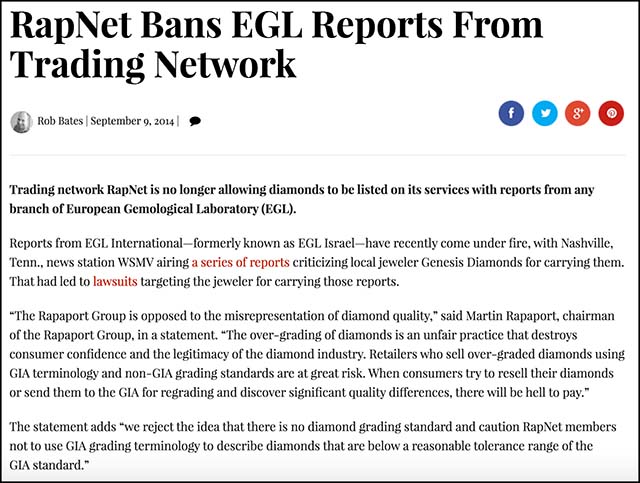
RapNet Bans EGL-graded Diamonds from the Largest Global Trading Network.
EGL Diamond Grading Lawsuit:
Is all of this blowing your mind? In the first place, the lawsuits referred to in the article originate from the law firm Cummings Manookian. The Diamond Lawsuit claims that:
"EGL issued bogus certificates purporting to grade the Four C's of the diamond. The bogus certificates were designed to look identical to legitimate GIA certificates and even use GIA's grading scale."
Here is a screenshot from the Cummings Manookian web site that shows that quote:

Lawsuit Claims EGL Issued Bogus Diamond Grading Certificates.
Now you see that I am not alone in my opinion that some "certificates aren't worth the paper they're written on." If you investigate the claim, you'll see that it does not involve the AGS, GIA, or HRD Belgium. The primary focus is on diamonds graded by the European Gemological Laboratory (EGL).
Under those circumstances, the statement issued by Cummings-Manookian refers to legitimate GIA certificates. As shown above, it implies that GIA grading standards are legitimate. Consequently, the GIA and AGS are sister organizations, and you can read about that in the article GIA vs. AGS Graded Diamonds - Which Gemological Laboratory is Best?
What Does "No BGM" Mean?
Occasionally, you might see the abbreviation "No BGM" used to describe diamond characteristics. Under those circumstances, you might find yourself wondering what "No BGM" stands for.
Diamond cutters may use the term "No BGM" as an additional description within the MLS. No BGM means no Brown or Grey undertones, and the diamond is not Milky.
- 1B = Brown.
- 2G = Grey undertones.
- 3M = Milky.
In the first place, this is something that you need to be aware of regardless of what diamond color you choose. However, I don't feel that this is something that you need to worry about if you buy from:
After all, they hand select every diamond for their inventory and consider this kind of thing. Secondly, the no BGM reference has nothing to do with blue fluorescence, and you will not see it on a lab report. The abbreviation is more of an internal reference for trade purposes.
Beyond the Basics:
So, now you know all about diamond color!
In the first place, you know that different lighting types will affect our perception of diamond color. Secondly, you got to watch a Brian Gavin Signature round diamond change color dramatically as it moved from room to room.
That is important because you might decide to save some money buying a lower color diamond. Plus, you got to see how dramatically different it looked under:
You're Practically an Expert:
That is outstanding because you know more about diamond color than most jewelers. In the first place, you know how lighting temperature will affect the appearance of diamond color.
Secondly, you also know that an I-color diamond can sparkle as exceptionally as a D-color diamond. After all, the diamond cut quality has more impact on light performance than the color grade. That is why I had Brian Gavin cut an I-color diamond for my wedding ring.
You Also Know the Effect All These Things Have Upon Diamond Color:
Plus, you know that blue fluorescence can improve our perception of diamond color by as much as one color grade! You also understand that those rumors about blue fluorescent diamonds looking milky or cloudy are little more than an urban myth.
Blue fluorescence has no negative impact on 98% of all gem-quality diamonds. Only diamonds with very strong to distinct blue fluorescence even have the possibility of looking over-blue.
What Else Did You Learn?
To begin with, do you remember why I don't recommend EGL graded diamonds? That's why you're only going to consider diamonds graded by the AGS, GIA, or HRD.
Remember the 1.255 carat, D-color, Internally Flawless clarity, Brian Gavin Signature round diamond from above. It's "dual certified" by both the AGS and GIA Laboratory with the same color and clarity grade. That shows that the GIA and AGS gemological laboratories evaluate by the same standards. Now you can put all of that "Is GIA better than AGS" stuff behind you. Whew! What a relief.
You also know to ignore those useless diamond color grading charts! Pen and ink illustrations of not-so-real diamond colors are not accurate. Printers' ink on paper does not represent the actual differences in hue and saturation that real diamonds exhibit.
What else did you learn? Oh yes, that's right. You now know all about the "No BGM" [Brown, Grey, Milky] trap. Imagine what it would be like to buy a G-color diamond out of virtual inventory. You receive the package. You open the box. Take out the diamond and discover that it is G-color with brown or grey undertones. Yuck. What a disappointment.
Mastering Diamond Color:
Congratulations on making it to the end of this in-depth tutorial on diamond color grading! At this point, you know more than 99.9% of people buying an engagement ring. You might even know more than some people working in the industry.
In that case, you've earned the recognition and respect that comes with being a Jedi Master of Diamond Color. With that in mind, the most important thing to remember about color is that it is a minor consideration. After all, the diamond's cut quality controls the sparkle factor and light performance.
Diamond Cut Quality is #1:
In the first place, remember that limiting your search to AGS Ideal and GIA Excellent is only the first step. Those overall cut grades do not take the optical precision into account.
That is crazy since the degree of optical precision has a direct impact on the intensity of sparkle! Secondly, you will need the following images to judge the degree of optical precision and light performance:
It can be challenging to interpret these images' meaning if you don't have a lot of experience. With that in mind, I recommend relying on my expertise (a shameless plug).
35+ years of diamond buying experience has its benefits, you know! In that case, I'm happy to help you pinpoint the subtle differences in diamond cut quality. Under those circumstances, your online diamond buying success is practically a given!
Let me know if you'd like my assistance searching for a diamond, and feel free to send me links to any diamonds that you might be considering.

